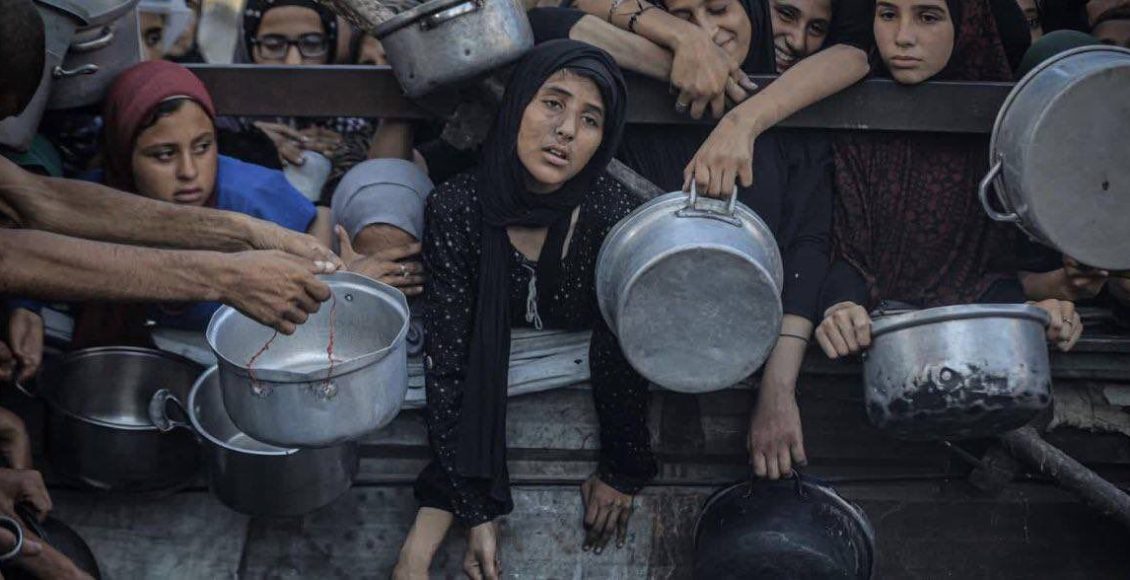At a moment when the cries of children are buried beneath the rubble of tents, and hunger becomes a tool of extermination witnessed by the world, Yemen’s streets erupted with calls for support.
The masses translated this bold decision into steps that know no retreat.
The sweeping public movement across the provinces came in direct response to the call of the Revolution Leader , Sayyed Abdul-Malik Badr al-Din al-Houthi, who clearly stated that escalatory options against the Zionist entity are under review. He called for opening the borders to allow Yemenis to join the fronts of dignity, and the public response matched the magnitude of the call.
The demonstrations reflected a strategic awareness rooted in the collective conscience of a people who see the starvation in Gaza as a clear declaration of confrontation. The masses advanced with deep consciousness into the squares, carrying banners with clear direction and a presence that embodied real engagement in a larger battle—one expanding with every step toward direct action that leaves no room for compromise in the face of genocide.
These rallies marked a qualitative shift in the nature of Yemen’s public response to the crime of starving Gaza. People expressed a move from symbolic expression to a state of practical readiness, linking the escalation of crimes in Gaza with the necessity of opening Yemen’s options across multiple fronts—an expression of deep awareness of the phase and its demands.
The speech of the revolutionary leader was proportionate to the gravity of the crime. He outlined an advanced course based on studying escalatory measures, explicitly called for opening routes for fighters, and tied the starvation in Gaza to the nation’s duty to take effective steps. This message resonated widely, met with a broad public response showing actual readiness to support and implement the decision.
The crowds understood the speech as a new phase of escalation in support of Gaza. They entered the streets with mature resolve, raising slogans that called for action, reinforced leadership direction toward escalation, and presented public support as a central pillar for upholding the stance and creating a suitable environment for sovereign decision-making within the broader battle of the nation.
A coherent political scene emerged in the protest squares, where fury met determination, and symbols of the cause rose to the level of moral weaponry. Voices united behind the frontlines, and the fighting spirit emerged clearly in the crowd’s slogans—expressing a deep realization that popular response is a vital arm in the battle for dignity unfolding in Gaza.
This mass momentum in Yemen coincided with the escalating crimes in Gaza, giving the Yemeni position a sense of urgency. It placed Yemen’s public momentum at the heart of direct support efforts and affirmed the country’s role as an influential player in the Arab political arena—capable of shifting the direction of action, altering the balance of response, and ready to bear the consequences when the time comes.
The public stance reflected an advanced alignment that went beyond emotional expression, moving toward supporting available political and military options. This stance harmonized with the contents of the leadership’s message, making it a reinforcement of the decision and paving the way for implementation—affirming that the people form the solid backbone of any forthcoming escalatory steps.
The massive turnout expressed a firm position that treats the famine in Gaza as a full-fledged war crime demanding immediate transition to action. The people’s clarity of vision confirmed that Yemen’s response is a strategic necessity in the face of regional and international moral collapse.
The statement issued at the rallies offered a precise description of the crime, identified the direct perpetrator, and held the American-Zionist alliance fully responsible—politically and morally. It declared that starvation and genocide are systematic tools used by the forces of aggression amidst the collapse of humanitarian cover and the fall of the so-called human rights systems.
The statement echoed the voice of the streets, bridging the political message with popular action. It emphasized that the masses moved out of faith, in response to religious duty, and in practical commitment to the path of jihad—reaffirming their principled stance linking Gaza with the broader battle of the ummah.
The crowd’s interaction with the statement embodied full endorsement of the announced path and readiness to bear the consequences of any escalatory decisions. The people granted the leadership practical authorization to manage the confrontation in a way that fits the requirements of the moment and honors Gaza’s ongoing suffering.
As the situation developed, the meaning of the rallies expanded—they became a tool of both internal and external public pressure, laying the foundation for a new political state that transcends traditional standards in dealing with central causes. The Yemeni model emerged as one of strategic clarity, advanced preparedness, firm direction, and cohesive stance.
The political landscape drawn by these demonstrations placed the Yemeni people at the center of the confrontation, reestablishing the role of popular will as an effective element in the battle and confronting the Zionist entity with a new reality where the people shift from moral pressure to political action on par with battlefield developments.
Yemen’s stance is undergoing a steady escalation, moving from a position of support to one of full partnership in the battle. It confirms that response options are now part of Yemen’s strategy in the liberation struggle and that the era of symbolic support has already been surpassed by a people who have shown their resolve in clear arenas and unwavering banners.
While Gaza suffers from systematic starvation, Yemen rallies its people—who view the scene with eyes of action—moving with political awareness toward a point of escalation against the extermination project. Yemen’s decision, now under study, is developing within a prepared public climate, a ready internal environment, and a regional stance leaning toward redrawing the lines of confrontation through direct means.

